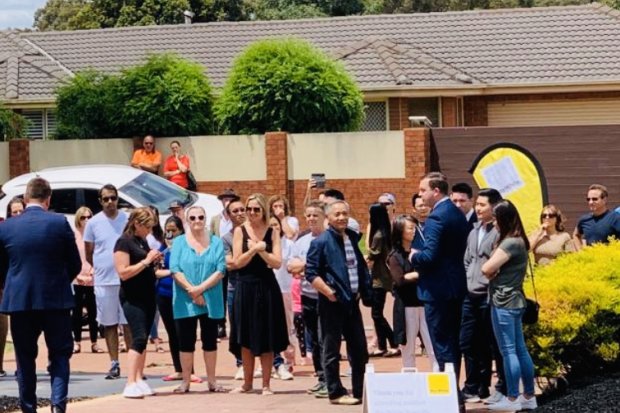- Home
- News & Media
- Virus poses ‘rising risk’ to housing market
Virus poses ‘rising risk’ to housing market
Australia’s housing market faces a new balancing act, with a looming interest rate cut expected to offset threats that the coronavirus could derail reinvigorated buyer sentiment.
Property prices across the country are recovering much faster than expected, with Sydney and Melbourne now growing annually at double-digit rates and values across five capital cities reaching a record high in February.

Darwin was the only capital city where home values fell, by 1.4 per cent, while Sydney recorded the strongest growth of 1.7 per cent over the month, followed by 1.2 per cent in Melbourne and 0.8 per cent in both Canberra and Hobart, according to CoreLogic’s Home Value Index.
For the first time since 2014, house values in Perth increased, albeit modestly, for four consecutive months, providing further evidence that the long-running downturn has come to an end.
While high auction clearance rates show buyers are back in force and the latest data from the Reserve Bank of Australia indicates investors are following owner-occupiers back into the property market – lending to investors grew in January, by 0.1 per cent, for the first time since December 2018 – the global spread of COVID-19 is now threatening to derail the strong house price trajectory.
“Last month I would have been more confident to say the trajectory will remain very strong. At the moment, there’s a lot of uncertainty around the economic impact of coronavirus,” CoreLogic’s director of research Tim Lawless said.
“Broadly what we’re seeing at the moment in Australia’s housing market is domestic demand is very strong, particularly from owner-occupiers. So in that sense, I think the impact from the coronavirus will be quite minimal.”
Flow-on effects
However, flow-on effects to the economy from less migration, less tourism and fewer education and commodity exports could start to filter through to the labour markets, which could affect confidence and have a dampening effect on the rapid rate of price growth, Mr Lawless said.
AMP Capital chief economist Shane Oliver warned the coronavirus was a “big and rising risk to the property market outlook”.
“If the situation badly worsens globally and the virus takes hold in Australia then it could become a big short-term negative as the economy slows even further potentially into recession, the loss of share market wealth drags on property demand and if people put off buying property along with other activities for fear of catching the virus.”
However, an interest rate cut as early as Tuesday could ward off such a threat and provide another boost to the already booming housing market.
“An interest rate cut will have some positive impact on the property market, it just depends how big the negative – in this case the coronavirus – is going the other way,” Mr Oliver said.
“That’s always been the thing in Australia, the negative has not been big enough to offset the positive of lower rates, which is why we keep meandering along with rising prices.”
The virus and its wider macroeconomic effects are already affecting some buyers. Melbourne buyers’ agent David Morrell didn’t attend the auction of a penthouse apartment in the city fringe suburb of Middle Park after the client who was planning to bid on it changed his mind.
“A sophisticated investor said ‘I’m concerned with where equity markets are going’,” Mr Morrell said on Monday. “And [he said] ‘I don’t think the virus has really played out, so I’m happy to sit on the fence’.”
It didn’t stop the property from selling – the three-bedroom apartment at 92/50 Canterbury Road went for $2.26 million.
Rapid recovery
Melbourne hit a new record high in property values in February, after a short nine-month recovery following a 19-month downturn.
“When we look at the recovery phase through this growth cycle, it’s been much more rapid than the previous recovery phases,” CoreLogic’s director of research Tim Lawless said.
“Historically the average time it takes for a market to recover is about the same time as it takes to reach a trough. Whereas this time around, we’ve seen most capital cities recover in half that time.”
Brisbane took 15 months to reach a trough but only seven months to recover.
Sydney is still below its peak, given a larger correction of 14.9 per cent over a 23-month downturn. It is only 3.7 per cent below its peak and is expected to reach a new record high in the next three months.
In Sydney and Melbourne, the upper end of the market is driving the increase in house prices. The upper quartile recorded a 10 per cent rise in values over the past four months compared with the lower quartile of just 3.4 per cent.
“There are a few things happening here,” Mr Lawless said. “One would be that we have seen that upper quartile show a much larger correction during the downturn and it also shows a much more rapid response during the upswing, which I think we can attribute to the fact that those housing prices did fall further.
“So in some ways, they’re much more affordable now than they used to be, at least relative to the incomes of people buying into those markets.
“And the second thing would be that as APRA changed the rules back in July last year around serviceability assessments it does imply that borrowing capacity has improved, which could be injecting more capital into the marketplace and enabling people to buy into those higher price points.”